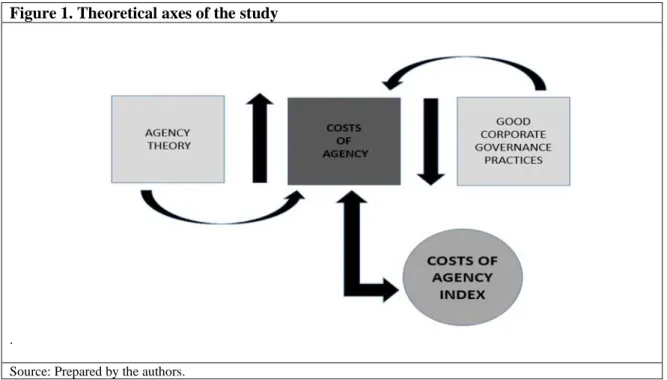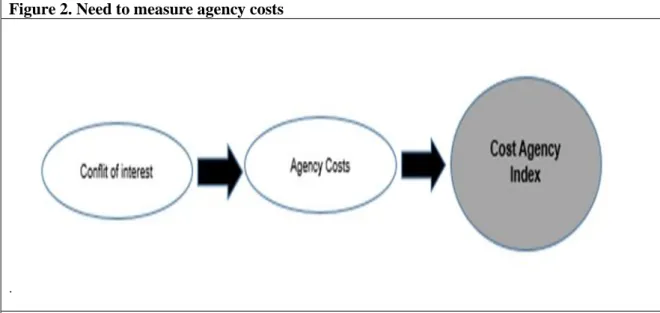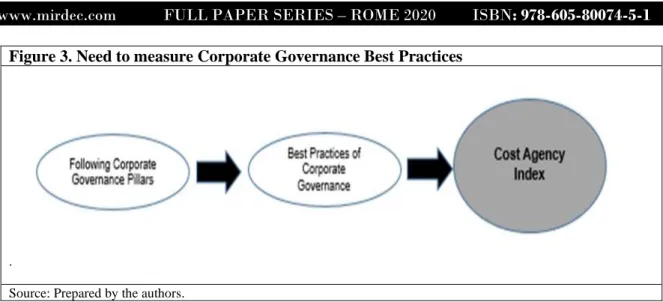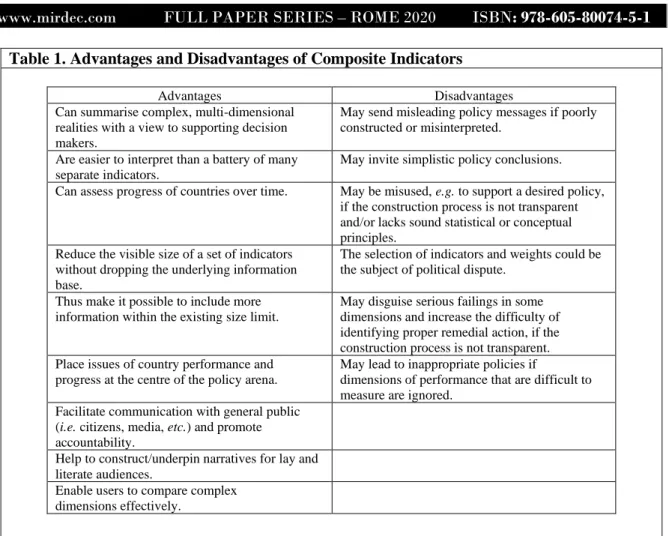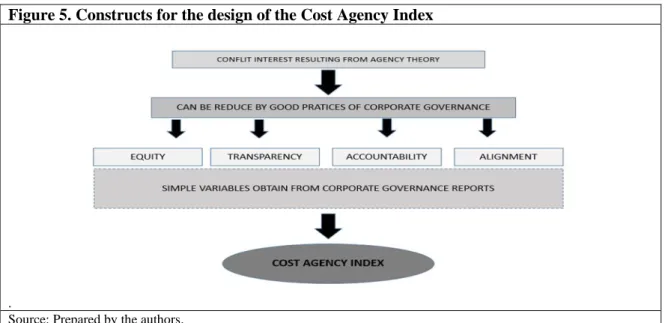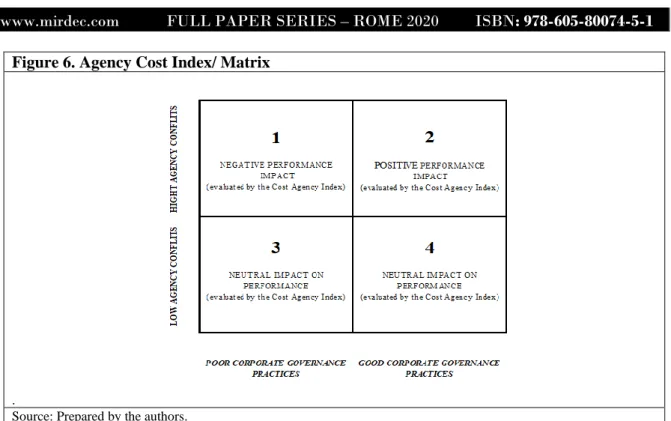Masters International
Research & Development Center
MIRDEC
International Academic Conference
MIRDEC-16th
International Academic Conference
Multidisciplinary Issues and Contemporary
Discussions in Social Science
(Global Meeting of Social Science Community)
CONFERENCE PROCEEDINGS
ROME 2020
FULL PAPER SERIES
ISBN: 978-605-80074-5-1
VIRTUAL/ONLINE CONFERENCE
5-7 April 2020
University of Washington, Rome Center
Rome, Italy
ANA QUARESMA1 AND SANDRA RIBEIRO2
COSTS OF AGENCY INDEX: THE NEED TO MEASURE AGENCY COSTS Abstract
This study aims to make known the need to create an indicator that can measure the agency costs resulting from agency conflicts set out in the agency's theory.
The increasing complexity of the management of organizations, coupled with increased dimensions and geographical coverage, most often their scope is reflected on a global scale, leads to the costs resulting from monitoring management, by the of the "owners" of capital are increasingly relevant, having an impact on the financial and stock performance of these same organizations.
Thus, in the present study will be exposed the foundations that will lead the authors to the design and creation of a Composite Indicator that will allow, through variables identified in the reports of corporate governance and constructed proxies, to the creation of the Costs of Agency Index. The main dimensions for their future elaboration and described will be explained also the associated advantages.
Keywords: Agency theory, agency costs, corporate governance, composite indicators JEL Codes:F60, M20
1. Introduction
Today's world has organizations of great complexity and size that are interconnected on a global scale. The sustainability of organizations requires management mechanisms and techniques in order that they can be competitive and perpetuated. The efficient and effective management of organizations requires that they integrate managers who are able to lead organizations to success.
The separation between property and management, a topic discussed for decades, has gained importance in the face of the growing need for organizations to be well managed by managers who do not own the capital. This situation is brought to its maximum exponent whenever we are in the presence of companies listed on the Stock Exchange.
This separation between ownership and management, referenced in the Agency Theory, generates conflicts of interest between the owners of the capital (principal) and the managers (agents). These conflicts of interest have a negative impact on organizations, resulting in Agency Costs.
The measurement of Agency Costs, through the Agency Cost Index, thus gains relevance to manage and anticipate possible negative impacts on the performance of the organization. The present study brings together the initial reflection of the authors in order to highlight the importance of their creation, what are the theoretical bases that underlie their conception and what is the methodology for their creation. The theoretical framework starts from the analysis of agency theory and associated agency costs, how good corporate governance practices, supported by its pillars, can reduce agency costs, and how composite indicators contribute to the measurement of several simple indicators.
1 OBSERVARE - Observatory of Foreign Relations, Universidade Autónoma de Lisboa Portugal, aquaresma@autonoma.pt. 2 OBSERVARE – Observatory of Foreign Relations, Universidade Autónoma de Lisboa Portugal, sribeiro@autonoma.pt, and
2. Theorical Revision
In this topic will be addressed the theoretical developments on the subjects that led to the design of the Cost Agency Index
The review of the literature that underlies the need to build an appointee for the measurement of agency costs is based on the following axes (see figure 1):
Figure 1. Theoretical axes of the study
.
Source: Prepared by the authors.
The premises that underlie the study are: the separation between property and management creates a conflict of interest between shareholders and managers; Corporate Governance good practices can reduce these conflicts of interest; the usefulness of composite indicators for measuring complex problems the construction of a composite indicator, called the Cost Agency Index, obtained from simple variables from the scope of Corporate Governance.
2.1. Agency Theory, Cost Agency and Cost of Agency Index
The separation between property and control in organizations management is a theme that has been in literature for some centuries. In 1776, Adam Smith in his work entitled the "The Wealth of Nations" raised the hypothesis that with the separation between property and control within organizations, they would be managed by people who would not have the same kind of interest and attention as those who and the owners. Almost two centuries later, Berle and Means (1932) in their study showed that the separation between property and control can provides administrators with the possibility of pursuing their interests for the interests of the owners, so it´s possible to see that the capital owners and the managements can have different interest in companies.
Jensen and Meckling (1976) state the concept of Agency Theory. It focuses on the analysis of conflicts arising within companies motivated by the divergence of interests of the various agents who directly participate in it. For the authors, the organization can be understood as a network of contracts, explicit or implicit, which establish the rights and duties of all those who intervene in corporate life. From these relationships, the figures of the 'principal' and the 'agent' appear. They identify two types of conflicts
between principals and agents: conflicts between shareholders (principal) and top managers (agent), and between creditors (principal) and shareholders (agent). There is often a misalignment of the interests and objectives between the principal and the agent leading to conflicts of interest stemming from the different interests and expectations. For one hand, as greater as the separation between the principal and the agent greater is the conflict of interest and on the other hand, too much concentration of power in agents may lead them to act first on the basis of their personal interests, leaving the interests of principals behind them.
The Stakeholder Theory presented by Donaldson and Preston (1995), showing that all stakeholders in organizations, in their relations with companies search for benefits and therefore there is no reason for choosing a set of interests to the detriment of others, prolonging the interaction of management with the stakeholders and not just with shareholders. Since then a lot of studies have motivated on this conception, however it is believed that the separation between ownership and management, becomes inescapable as markets become more developed as such as the Agency Cost resulting from that. Fama (1980) says that the agency's theory deals with the separation between company ownership and management, based on the motivation of individual agents and the analysis of conflicts and costs resulting from ownership and capital control. Ali (2014) identifies two types of agency conflicts: at a first level and that develop based on the relationship between managers and stakeholders; at a second level because they are generated between majority and minority shareholders. In markets where there is a larger concentration of capital, or there is weak legal protection of minority shareholders, those of the second level tend to be more frequent (La Porta et al., 2000). When there is a high concentration of the company's capital, agency conflicts arise not only between shareholders and managers but also between majority shareholders and minority shareholders, called the principal-principal agency problem (Fan & Wong, 2005).
.
Based on the assumption that agency conflicts result in costs for the organization, that negatively translate into their profits, the objective of the study is to identify the need to create an Index that can measure these agency costs (figure 2).
Figure 2. Need to measure agency costs
.
2.2. Corporate Governance Pillars, Good Corporate Governance and Cost Agency Index
Agency theory is part of the bigger topic of Corporate Governance: It involves the problem of directors controlling a company whilst shareholders own the company; In the past, a problem was identified whereby the directors might not act in the shareholders (or other stakeholders) best interests; Agency theory considers this problem and what could be done to prevent it. Good Corporate Governance is based on Principles for the Best Practices of Corporate Governance. The Principles of Corporate Governance (OCDE, 2015) are supporting on: Ensuring the Basis for an Effective Corporate Governance Framework; The Rights of Shareholders and Key Ownership Functions; The Equitable Treatment of Shareholders; The Role of Stakeholders in Corporate Governance; Disclosure and Transparency; The responsibilities of the Board.
According Shleifer and Vishny (1997, p.743) “corporate governance deals with the ways in which suppliers of finance to corporations assure themselves of getting a return on their investment”. Meireles (2005) in his study says that organizations should adopt a Corporate Governance model that takes into consideration the pillars of equity, fair treatment of all shareholders regardless of their participation in share capital, transparency, i.e., management should timely and clearly disseminate corporate information in order to reduce the asymmetry of information, accountability of management for corporate governance acts and alignment of interests between management and shareholders in particular , and stakeholders in general.
According OCDE (2004, p.17) “The corporate governance framework should promote transparent and efficient markets, be consistent with the rule of law and clearly articulate the division of responsibilities among different supervisory, regulatory and enforcement authority”. In consequence the Principles of Corporate Governance must ensuring the basis for an effective Corporate Governance Framework. According OECD (2017) “Good corporate governance helps to build an environment of trust, transparency and accountability necessary for fostering long-term investment, financial stability and business integrity, thereby supporting stronger growth and more inclusive societies”
The performance of organizations, the financial information they prepare and disseminate, access to capital and the composition of the Board of Managements are focuses of attention of corporate governance systems (Gregory & Simmelkjaer, 2002). However, these systems do not present an objective way of testing and identifying to what extent good corporate governance is practiced and achieved, i.e. what capacity of organizations to effectively and efficiently meet their objectives and at the same time take into account the interests of all parties related to the company, including society in general (Turnbull, 2011). In this way, the Cost Agency Index will be able to measure agency costs, resulting from agency conflicts, by observing the good practices of Corporate Governance adopted in the organization. Thus it can be said that the Cost Agency Index will contribute to measuring good practices of Corporate Governance on this dimension (figure 3).
Figure 3. Need to measure Corporate Governance Best Practices
.
Source: Prepared by the authors.
2.3. Composite Indicators and Cost Agency Index
In economic science, the use of indicators is very frequent in order to measure economic activity, and variables that compose it. This quantification can be done in isolation (where only a partial aspect of the reality under study is reflected), and the indicators are designated as simple, or can be used together, the indicators called compounds. Composite indicator result from the combination of several simple indicators, to which we assign equal or different weightings that are considered representative of a given reality.
Composite indicators measure concepts which can be multi-dimensional and cannot be defined by using a unique single indicator. They are very useful in order to compare country performances and are very important in policy communication (Saltelli 2007 and Nardo et al. 2005).
Munda (2012) states that “from a formal point of view, a composite indicator is an aggregate of all dimensions, objectives, individual indicators and variables used for its construction.” Also Freudenberg (2003), argues that “composite indicators are increasingly being used to make cross-national comparisons of country performance in specified areas such as competitiveness, globalization, innovation, etc. Rather than using a disaggregated menu of individual indicators, aggregated composites supposedly allow for analysis of interrelated performance or policy areas. They are popular in benchmarking exercises where countries wish to measure their performance relative to other countries and identify general areas where national performance is below expectations. Benchmarking with the aid of composites is often used to identify general trends, determine performance targets and set policy priorities.” This is the main advantage of using a composite indicator that leads us to choose one in our study.
There are many advantages, but also limitations that lead to some precautions in the use of indicators, whether simple or compound. For although they are useful tools for any study, they are ultimately insufficient given the fact that they cannot translate the totality of the reality to be studied.
In the following table, the OECD (2008) presents the advantages and disadvantages of using composite indicators:
Table 1. Advantages and Disadvantages of Composite Indicators
Advantages Disadvantages
Can summarise complex, multi-dimensional realities with a view to supporting decision makers.
May send misleading policy messages if poorly constructed or misinterpreted.
Are easier to interpret than a battery of many separate indicators.
May invite simplistic policy conclusions. Can assess progress of countries over time. May be misused, e.g. to support a desired policy,
if the construction process is not transparent and/or lacks sound statistical or conceptual principles.
Reduce the visible size of a set of indicators without dropping the underlying information base.
The selection of indicators and weights could be the subject of political dispute.
Thus make it possible to include more information within the existing size limit.
May disguise serious failings in some dimensions and increase the difficulty of identifying proper remedial action, if the construction process is not transparent. Place issues of country performance and
progress at the centre of the policy arena.
May lead to inappropriate policies if
dimensions of performance that are difficult to measure are ignored.
Facilitate communication with general public (i.e. citizens, media, etc.) and promote accountability.
Help to construct/underpin narratives for lay and literate audiences.
Enable users to compare complex dimensions effectively.
.
Source: OCDE (2008).
There are three determinants in having a good composite indicator (Tarantola 2010): a relevant theoretical framework, good quality of the data and a good methodology in the construction of the indicator in the standard practice.
Nardo et all (2005) consider that the concept of quality of the composite indicators is not only a function of the quality of its underlying data (in terms of relevance, accuracy, credibility, etc.) but also of the quality of the methodological process used to build the composite indicator itself. The safe use of the composite requires proper evidence that the composite will provide reliable results. In this context, good practices of Corporate Governance, can reduce the agency cost, and can be measured by a composite indicator (figure 4).
Figure 4. Need to measure Corporate Governance Best Practices
.
Source: Prepared by the authors.
3. Cost Agency Index
After the review of literalness, where the constructs were collected for the explanation of Composite Index Namely Cost Agency Index (figure 5):
Figure 5. Constructs for the design of the Cost Agency Index
.
Source: Prepared by the authors.
The future design of the composite indicator, Agency Cost Index, will have applicability for the management of organizations, being able to evaluate the impact in organizational performance derived from Agency Costs. Figure 6 intends to re-feel the above.
Figure 6. Agency Cost Index/ Matrix
.
Source: Prepared by the authors.
Corporate Governance good practices have a positive impact on organizational performance evaluated by the Cost Agency Index. The matrix above relates this good practices of Corporate Governance (x- axis) with the intensity of the organization's agency conflicts (y- axis) Analyzing the quadrants of the matrix will be possible to evidence the following: Whenever Agency Conflicts are very low, or null, the good Corporate Governance practices reflected by the Cost Agency Index have no impact on organizational performance, not because they have no impact on organizational performance but evaluated by the indicator under study. This situation can be identified in quadrants 3 and 4 of the matrix. Quadrant 1 of the matrix reflects the situation in which Agency Conflicts are elevated and Corporate Governance practices are poor, leading to the value of the Cost Agency Index being high with a negative impact on organizational performance. The positive impact on organizational performance can be verified in quadrant 2 where Cost Agencies are elevated but mitigated by good Corporate Governance practices resulting in a low Cost Index value.
This matrix can lead to a management reflection for the implementation of good Corporate Governance practices with a view to reducing the value of the indicator and improving organizational performance.
4. Conclusions
The agency conflicts that exist between the Board of Directors and the shareholders (in a broader perspective the stakeholders), explained in the framework of the Agency Theory, are mentioned as one of the main problems of corporate governance models. The OECD (2004) mentions that there is no single corporate governance model, as the models should take into account internal factors of the organization itself (culture, structure, size, etc.) and external factors to the organization (state of maturity of the capital market, access to bank financing, legal and governmental restrictions, etc.). From this triangulation we can identify the usefulness of the Cost Agency Index, measuring the agency costs of the organization associated with corporate governance practices, obtained through the construction of a composite indicator, enabling the evaluation of organizational performance. which constituted the main objective of this work. Based on the premise of the lack of a universal corporate governance model, it is taken for granted that good practices in this area contribute to the reduction of agency conflicts and consequently the reduction of agency costs.
The present work sought to discuss and perceive the influence of Good Corporate Governance Practices on business performance, with a particular focus on reducing agency conflicts and consequently reducing agency costs. It also reflects the need to build a composite index, obtained from the integration of simple variables, which reflect the best, or worse, practice of corporate governance of organizations, leading to the idealization of a composite index called Cost Agency Index. This is an embryonic study that serves as the basis for the study, to be developed by the authors, in which it will be presented not the need and usefulness of the existence of the Cost Agency Index but its construction and applicability in organizations.
References
Ali, C.B. (2014). Corporate Governance, Principal-Principal Agency Conflicts, and Disclosure. IPAG Business School.
Berle, A.; Means, G. (1932). The Modern Corporation and Private Company – New York: Macmillan Donaldson, L.; Preston, L. (1985). The Stakeholder Theory of the Modern Corporation: Concepts, Evidences and Implications – Academy of Management Review, nº 20, p. 65-91.
Fama, E.F. (2003). Agency Problems and Residual Claims. Journal of Law & Economics, EUA, Vol.26. Fan, J., & Wong, T. (2005). Do External Auditors Perform a Corporate Governance Role in Emerging Markets? Evidence from East Asia. Journal of Accounting Research, 43 (1), 3572.
Freudenberg, M. (2003). "Composite Indicators of Country Performance: A Critical Assessment" in OECD Science, Technology and Industry Working Papers, 2003/16, OECD Publishing. doi:10.1787/405566708255.
Gregory, H., & Simmelkjaer, R. (2002). Comparative Study of Corporate Governance Codes Relevant to the European Union and its Member States. Final report & Annexes I−III. New York: Weil, Gotshal & Manges, LLP.
Jensen, M.C.; Meckling, W. (1976). Theory of Firm: Managerial Behaviour, Agency Cost and Ownership Structure; Journal of Financial Economics; Vol. 3.
La Porta, R. Lopez-de-Silanes, F. Shleifer, A. & Vishny, R. (2000). Investor protection and corporate governance. Journal of Financial Economics, pp. 3-27.
Meirelles, F.S. (2005) Survey of Information Resources Management, 16th Edition, São Paulo, EAESP-FGV.
Munda. (2012). Choosing Aggregation Rules for Composite Indicators Social Indicators Research · 109:337–354.
Nardo, M.; Saisana, M.; Saltelli, A.; Tarantola, S.; Hoffman, A. and Giovannini, E. (2005). Handbook on constructing composite indicators: methodology and user guide, OECD Statistics Working Paper, Paris.
OCDE (2004). Principles of Corporate Governance [Consult. 10.11.2019].
http://www.oecd.org/daf/ca/corporategovernanceprinciples/33931148.pdf.
OECD (2008). Handbook on constructing composite indicators: methodology and user guide – ISBN 978-92-64-04345-9 - © OECD 2008.
OCDE (2015). Corporate Governance Factbook. Bruxelas: OCDE. OECD (2017), OECD Corporate Governance Factbook 2017.
Saltelli, A. (2007). “Composite indicators between analysis and advocacy” in Social Indicators Research, 81: 65-77.
Shleifer, A; Vishny, R. (1997) A Survey of Corporate Governance, 52 Journal of Finance pag.737-783. Smith, A. (1776). Riqueza das Nações. (7). Portugal: Fundação Caloust Gulbenkian.
Tarantola, S. (2010). “Ten steps to build Composite Indicators", QMSS-2 Vienna, September 2-nd 2010. Turnbull, S. (2011). Toward a Good Society in the Twenty-First Century. Palgrave Macmillan US, Ed. Achieving Environmental Sustainable Prosperity, prosperity (75-103).
